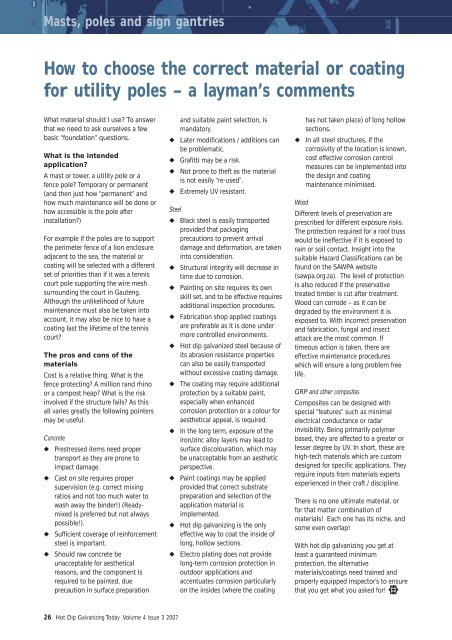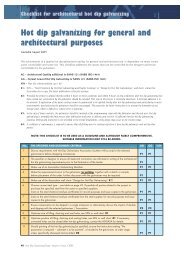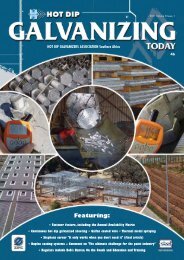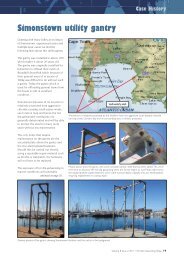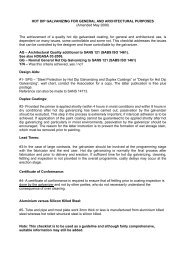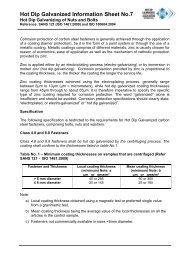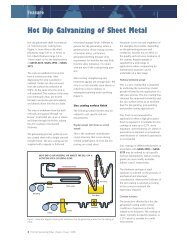Featuring: - hdgasa
Featuring: - hdgasa
Featuring: - hdgasa
You also want an ePaper? Increase the reach of your titles
YUMPU automatically turns print PDFs into web optimized ePapers that Google loves.
Masts, poles and sign gantries<br />
How to choose the correct material or coating<br />
for utility poles – a layman’s comments<br />
What material should I use? To answer<br />
that we need to ask ourselves a few<br />
basic “foundation” questions.<br />
What is the intended<br />
application?<br />
A mast or tower, a utility pole or a<br />
fence pole? Temporary or permanent<br />
(and then just how “permanent” and<br />
how much maintenance will be done or<br />
how accessible is the pole after<br />
installation?)<br />
For example if the poles are to support<br />
the perimeter fence of a lion enclosure<br />
adjacent to the sea, the material or<br />
coating will be selected with a different<br />
set of priorities than if it was a tennis<br />
court pole supporting the wire mesh<br />
surrounding the court in Gauteng.<br />
Although the unlikelihood of future<br />
maintenance must also be taken into<br />
account, it may also be nice to have a<br />
coating last the lifetime of the tennis<br />
court?<br />
The pros and cons of the<br />
materials<br />
Cost is a relative thing. What is the<br />
fence protecting? A million rand rhino<br />
or a compost heap? What is the risk<br />
involved if the structure fails? As this<br />
all varies greatly the following pointers<br />
may be useful.<br />
Concrete<br />
◆ Prestressed items need proper<br />
transport as they are prone to<br />
impact damage.<br />
◆ Cast on site requires proper<br />
supervision (e.g. correct mixing<br />
ratios and not too much water to<br />
wash away the binder!) (Readymixed<br />
is preferred but not always<br />
possible!).<br />
◆ Sufficient coverage of reinforcement<br />
steel is important.<br />
◆ Should raw concrete be<br />
unacceptable for aesthetical<br />
reasons, and the component is<br />
required to be painted, due<br />
precaution in surface preparation<br />
◆<br />
◆<br />
◆<br />
◆<br />
and suitable paint selection, is<br />
mandatory.<br />
Later modifications / additions can<br />
be problematic.<br />
Grafitti may be a risk.<br />
Not prone to theft as the material<br />
is not easily “re-used”.<br />
Extremely UV resistant.<br />
Steel<br />
◆ Black steel is easily transported<br />
provided that packaging<br />
precautions to prevent arrival<br />
damage and deformation, are taken<br />
into consideration.<br />
◆ Structural integrity will decrease in<br />
time due to corrosion.<br />
◆ Painting on site requires its own<br />
skill set, and to be effective requires<br />
additional inspection procedures.<br />
◆ Fabrication shop applied coatings<br />
are preferable as it is done under<br />
more controlled environments.<br />
◆ Hot dip galvanized steel because of<br />
its abrasion resistance properties<br />
can also be easily transported<br />
without excessive coating damage.<br />
◆ The coating may require additional<br />
protection by a suitable paint,<br />
especially when enhanced<br />
corrosion protection or a colour for<br />
aesthetical appeal, is required.<br />
◆ In the long term, exposure of the<br />
iron/zinc alloy layers may lead to<br />
surface discolouration, which may<br />
be unacceptable from an aesthetic<br />
perspective.<br />
◆ Paint coatings may be applied<br />
provided that correct substrate<br />
preparation and selection of the<br />
application material is<br />
implemented.<br />
◆ Hot dip galvanizing is the only<br />
effective way to coat the inside of<br />
long, hollow sections.<br />
◆ Electro plating does not provide<br />
long-term corrosion protection in<br />
outdoor applications and<br />
accentuates corrosion particularly<br />
on the insides (where the coating<br />
◆<br />
has not taken place) of long hollow<br />
sections.<br />
In all steel structures, if the<br />
corrosivity of the location is known,<br />
cost effective corrosion control<br />
measures can be implemented into<br />
the design and coating<br />
maintenance minimised.<br />
Wood<br />
Different levels of preservation are<br />
prescribed for different exposure risks.<br />
The protection required for a roof truss<br />
would be ineffective if it is exposed to<br />
rain or soil contact. Insight into the<br />
suitable Hazard Classifications can be<br />
found on the SAWPA website<br />
(sawpa.org.za). The level of protection<br />
is also reduced if the preservative<br />
treated timber is cut after treatment.<br />
Wood can corrode – as it can be<br />
degraded by the environment it is<br />
exposed to. With incorrect preservation<br />
and fabrication, fungal and insect<br />
attack are the most common. If<br />
timeous action is taken, there are<br />
effective maintenance procedures<br />
which will ensure a long problem free<br />
life.<br />
GRP and other composites<br />
Composites can be designed with<br />
special “features” such as minimal<br />
electrical conductance or radar<br />
invisibility. Being primarily polymer<br />
based, they are affected to a greater or<br />
lesser degree by UV. In short, these are<br />
high-tech materials which are custom<br />
designed for specific applications. They<br />
require inputs from materials experts<br />
experienced in their craft / discipline.<br />
There is no one ultimate material, or<br />
for that matter combination of<br />
materials! Each one has its niche, and<br />
some even overlap!<br />
With hot dip galvanizing you get at<br />
least a guaranteed minimum<br />
protection, the alternative<br />
materials/coatings need trained and<br />
properly equipped inspector’s to ensure<br />
that you get what you asked for!<br />
26 Hot Dip Galvanizing Today Volume 4 Issue 3 2007


